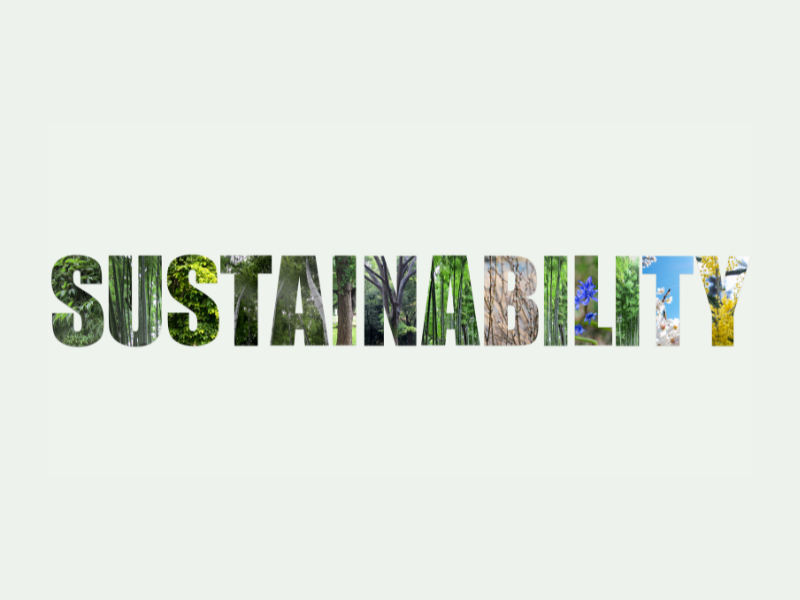Your Guide to Sustainable Activewear
Sustainability is of growing importance to all walks of life - and for good reason. The planet is in trouble and there is still a short window of opportunity to undo some of the damage.
Nearly everyone, citizen and corporation alike, are leaning in to make changes. And few industries need to make drastic adjustments more than apparel.
The fashion industry accounts for 10% of the planet's carbon emissions. And its heavy reliance on petroleum-based and non-biodegradable fabrics is exacerbating the issue in the present, and certainly in the future.
For instance, go into any local sporting goods store, and head to a section with apparel. On average, 60% of all the garments in that section will include virgin polyester - which is a petroleum-dependent fiber.
With Covid-19 spiking interest in exercise and wellness, the growth of activewear has skyrocketed in parallel.
And due to the alignment of exercise demands on apparel and the performance properties of polyester, this has brought unfortunate consequences to the environment.
It's not all doom and gloom though. Consumers are more aware than ever and even more important, they are taking action and demanding brands they use, love, and advocate on behalf of, take action as well.
People want to be able to wear clothing that doesn't hurt the environment, and they want to know where their clothes are coming from. And if you work in performance apparel, this is an important realization for today's success, and certainly, tomorrow's as well.
If your performance apparel brand is seeking more sustainable practices, or change management has already begun, then this guide will serve as your 101 for the transition.
Through the lens of friendly environmental practices, this guide will walk you through a few key elements to becoming an eco-friendly performance apparel brand today, including:
Building Blocks: Fibers and fabrics
The Process: Sourcing and manufacturing
Brand in Demand: An eco-friendly brand surging in popularity
This guide is dense, and there's a lot to get through, so let's get started.
The Building Blocks of Eco-Friendly Performance Apparel
Eco-friendly activewear starts with the materials. There are numerous options for materials, and nearly limitless options for blends, but ultimately determining if a garment is eco-friendly comes down to the fiber; determining if it's natural or synthetic.
Natural and Synthetic Fibers
To environmental demise, most activewear and athleisure apparel are made from synthetic fibers, whether that's entirely or just as part of a blend.
At times they can offer properties that some natural fibers don't, but most often, synthetic fibers are chosen because of their lower cost and accessibility.
Natural Fibers: Natural fibers are made from, well, nature - plants, and animals (wool for instance.) They are renewable and biodegradable.
Synthetic Fibers: Conversely, synthetic fibers are made from petroleum products - think crude oil. They're cheap to produce but not environmentally friendly because they're non-biodegradable (meaning they'll never decompose).
On the other hand, natural fibers can be more expensive and sometimes have shorter shelf lives.
But as awareness of the eco-friendly movement has risen, and with it, an increase in demand, the prices of natural fibers are dropping while quality is rising.
Popular Natural Fibers
Cotton: Cotton is a popular fabric choice because it's soft, absorbent, and breathable. It's often used in t-shirts, underwear, and towels.
Linen: Linen is made from the flax plant and it's strong and absorbent. It's a popular summer fabric because it's lightweight and airy.
Bamboo: Bamboo is a sustainable grass that's often used in textile production. It's soft, absorbent, and antibacterial.
Popular Synthetic Fibers
Polyester: Polyester is the most common synthetic fiber and it's used in activewear because it's lightweight and quick-drying.
Nylon: Nylon is a strong, durable synthetic fiber that's often used in sportswear.
Lycra: Lycra is a stretchy synthetic fiber that's often used in yoga pants and other form-fitting clothing.
Eco-Friendly Alternatives to Synthetic Fibers
Producing polyester, nylon, or any synthetic fiber negatively impacts the environment and human health. And while there are some unique performance benefits to these synthetic fibers, there are fortunately also eco-friendly alternatives that offer similar properties.
The most common alternative to polyester is recycled polyester, which is made from recycled plastic bottles and has the same properties as virgin polyester.
The downside is that it requires plastic to exist at a prior stage, but the upside is that it's reducing waste going into landfills and decreasing demand for the production of virgin polyesters.
This is a rather popular solution to, Unifi, the parent company of a renowned recycled polyester manufacturer called Repreve, which has recycled 34 billion plastic water bottles in this process or similarly.
For nylon, which is also a popular synthetic fiber, especially in outerwear, recycled nylon is the equivalent sustainable alternative.
Where recycled polyester is primarily created from plastic bottles, recycled nylon is sourced from pre and post-consumer waste, like carpeting and fishing nets, which would otherwise end up in landfills.
Trending Eco-Friendly Fabrics in Activewear
Fabrics created from organic cotton, modal, lyocell, and recycled polyester are several well-known examples of textiles made from sustainable materials (certainly with a caveat on recycled polyester), but other eco-friendly fabrics are trending in activewear that you should know about.
For instance, Bamboo Charcoal® is an organically sourced fiber with a nanotechnology twist on the increasingly popular bamboo fabrics.
Bamboo Charcoal® - Organic Natural Fibers With Nanotechnology
Since the 90s, bamboo has quickly become a popular organic resource. Bamboo Charcoal® is the next generation of this, which incorporates bionanotechnology to create a durable, soft, and absorbent fabric.
Bamboo Charcoal® is made by burning bamboo in an oxygen-free environment, which creates charcoal. This charcoal is then ground into a powder and combined with other natural fibers to create a textile.
While it may share a similar name, Bamboo Charcoal® fabric is completely different from bamboo fabric - Bamboo Charcoal® has less of a sheen and more of linen feel compared to conventional bamboo fabrics' silky look and feel.
A few of the many additional benefits of Bamboo Charcoal® fabric include:
Hypoallergenic and Antibacterials - Anti-allergy, anti-fungal, and antibacterial properties of bamboo naturally create a comfortable garment for those with sensitive skin, or who sweat profusely resulting in odorous garments.
Thermal Control - Bamboo's cellulose structure uniquely allows the fabric to trap heat as needed, while still being breathable, offering great flexibility for activewear.
Environmental Impact - Bamboo is sustainable and regenerative, growing quickly without complex water treatment or chemicals.
Bamboo Charcoal® is one of the next big eco-friendly solutions that will gain additional traction in the next couple of years.
But there are a few other eco-friendly fabrics that you'll begin seeing more and more; including the 5 Trending Eco-Friendly Fabrics in Activewear.
Creating Eco-Friendly Performance Apparel
Today's consumers demand more from sustainable apparel than in the past. Previously, using natural fibers or a blend that reduced synthetic fiber use may have been enough.
But now, consumers want full transparency across the entire supply chain.
Details around how their garments are made, where they are coming from, and the entire ecological footprint to create a specific clothing item.
Greenwashing is no longer tolerated, so brands must be ready to answer the hard questions, especially if your brand lacks the transparency they're seeking.
The process of creating eco-friendly performance apparel is not significantly different from conventional garments, but at each stage, there are areas to significantly improve.
Focusing on just two of the many stages of the supply chain, sourcing, and manufacturing, it becomes abundantly clear that simple changes can profoundly disrupt or enhance a garment's ecological footprint.
Let's have a closer look at sourcing and manufacturing garments, and a few sustainable improvements that can be made within each.
Sourcing: Eco-Materials vs Materials
Raw materials are the backbone of any sustainable practice - opting for renewable over non-renewable resources is one of the basic tenets.
But today's eco-materials options are far more diverse than just organic. Beyond organic cotton or other well-known sustainable materials, a few key areas of eco-material sourcing include forestry, pre-consumer recycling, post-consumer recycling, and upcycled.
Sustainably Managed Forests for Apparel:
Trees are a renewable resource, and when managed responsibly, can provide an eco-friendly option for sourcing performance apparel. Forest Stewardship Council (FSC) certified garments signify sustainably managed and sourced apparel from species of trees.
Trees act as the raw material for several fabrics like modal, viscose, rayon, and lyocell. Lyocell can be created from a variety of trees, including birch, oak, and eucalyptus.
Pre-Consumer Recycled Clothing:
Recycling clothes into new garments is a process that has been going on for centuries. However, this is a bit different. Creating apparel lines includes a massive amount of material and scraps.
Those raw materials, which may be completely intact, would rarely make it into the consumer's hands even though they are perfectly fine.
Pre-consumer recycling finds new life for threads and scraps and creates new textiles with them instead of dropping them in landfills.
Post-Consumer Recycling Clothing:
Post-consumer recycled garments are garments that have been worn and then turned in to be recycled into new clothes, or taken waste from landfills and using it to create a garment.
In the process of mass production, this often takes the form of recycled waste - like recycled nylon or recycled polyester.
Upcycled Apparel:
Upcycled garments are created when waste from the manufacturing process, or other products, is used to create a new piece of clothing.
This could be as simple as using fabric scraps to create a patchwork design or taking an old t-shirt and upcycling it into a new garment. Denim is one of the most popular examples of this.
Manufacturing: Sustainable vs Conventional
Manufacturing fabrics are notoriously wasteful. From the energy and water required to spin, to harmful solvents and dyes dropped in waterways, it has a less-than-sterling reputation.
But there are solutions in practice today, and incoming innovations to combat the environmental harm caused by textile manufacturing.
Here are a few key areas of focus:
Decreasing Energy Demand:
The textile industry is one of the most energy-intensive in the world. Reducing raw materials to a fibrous form, spinning those fibers into thread, and weaving them into fabric is a multi-step journey, each with an intense need for power.
Although a small minority at this point, manufacturers are beginning to install alternative and sustainable sources of energy onto their plants. Such as solar power.
By no means is the problem solved let alone widely adopted, but serves as an early signal of what's to come in the future of sustainable energy for manufacturing clothing.
Reducing Water Consumption:
For anyone doubting the enormous water consumption of the textile industry, two facts cement this unlikable position.
The textile industry is the second most water-intensive industry on the planet, just behind fruit and vegetable agriculture.
It takes approximately 2700 liters (700 gallons) of water to produce the cotton for just one t-shirt.
Manufacturers, like Tencel in its Tencel Lyocell production, have incorporated a method that reuses 99% of its solvent-mixed water on each production run. Which is a double victory for reduced water use and less pollution released into waterways.
Reducing water consumption through innovative reuse techniques, in addition to wholly new innovations, will result in the industry weening itself from its intense water consumption behaviors.
Eco-Friendly Dyes:
Dyeing is one of the most polluting processes in the textile industry - and can be exceedingly hazardous for employees. But it doesn't have to be.
Eco-friendly dyes are those that don't require large amounts of water, don't produce toxic wastewater, and often forego the use of heavy metals and other harmful chemicals during production.
Many eco-friendly dyes are plant-based, using roots, bark, and leaves to produce a wide range of hues and shades.
The Full Supply Chain
While only two broad stages of the supply chain (sourcing and manufacturing) were discussed at a broad level, there are far more stages and steps in between that truly make a garment sustainable or not.
For a more comprehensive look and guidance on eco-friendly solutions, head over to Sport Casuals' article on Sustainable Decisions Throughout the Clothing Supply Chain.
You'll find far more detail on both sourcing and manufacturing, as well as distribution.
Trending Eco-Friendly Activewear Brands
There's a perception eco-friendly activewear, or apparel for that matter can only be made at an unreasonable premium or compromised performance and style.
And while this may have been true only a decade ago, the advancements in technology and processes make both of those assessments largely antiquated.
That's not to say that there isn't a cost difference - most of the time sustainable activewear is more expensive to source than alternatives. The point is it's not unreasonable.
Brands that invest in sustainable solutions use marketing and clear eco-friendly signage as a way to promote a sale, to offset increased COGS through increased transactions.
And as it relates to performance and style, this is far from accurate.
The trajectory of activewear is positive - but there are break-out brands that go above and beyond this already high growth, and nearly all of them are built through sustainable methods.
And they aren't shy about owning this in their marketing as well.
A whole cast of brands exists at this level, and nearly every month a new one enters the sustainable activewear space with eager customers awaiting them.
Rising Eco-Friendly Activewear Brand
Outside of anecdotes or experience, the following brand is from a list of seven rising activewear brands.
Built from Google search consumer data related to "activewear" and "athleisure." - within the past 12 months, the following brand is among the top 50 brands (sustainable and not) talked about online within the United States.
d+k active: Luxury Activewear
Based in Australia, d+k active has been around for several years, but in the past 12 months, a rising tide of US consumers has taken to the brand.
But sustainability and ethical manufacturing are still front-and-center for the brand; including:
Eco-Friendly Fabrics: Econyl (regen. nylon), organic cotton, bamboo, modal - all fabrics OEKO-TEX Standard 100 and REACH certifications
Energy Source: Solar-powered office and factory
Ethical Manufacturing: Australian certifications
Packaging: 100% compostable packaging - non-toxic and biodegradable, sourced from plants.
You can find the full d+k active sustainability report for 2022 on their site.
For a more detailed look at d+k active and other rising stars in the space, check out the Sport Casuals' article, 5 Sustainable Activewear Brands On The Rise.
You'll find a breakdown of how each goes to market with a sustainability message.
Environmental Action is Key to Activewear Success
As an eco-friendly brand, your sourcing and manufacturing processes reflect your commitment to sustainability. The days of having 40% cotton, or reducing petroleum-based packaging by 10% as your sustainability plan aren't enough.
To build a successful activewear brand today, you'll need to fully commit to practices that are sustainable across the entire supply chain.
Using innovative fibers and fabrics, to create amazing garments that don't sacrifice performance in the name of sustainability - rather, can manage both with excellence.
It's a new era for apparel, and the brands that are at the forefront of this change will reap the benefits for years to come.







